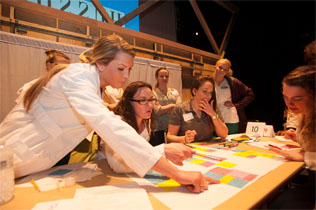- Home
- News
- 2017 Press Releases
- Fifth Annual Interprofessional Evening of Conversation for Aspiring Healthcare and Education Professionals to Focus on Patients with Opioid Addictions
Fifth Annual Interprofessional Evening of Conversation for Aspiring Healthcare and Education Professionals to Focus on Patients with Opioid Addictions
Published on: February 9, 2017

BANGOR, MAINE - More than 300 students from Husson University, will participate in the Fifth Annual Interprofessional Evening of Conversation on February 23, 2017 from 5:30 p.m. – 8 p.m. at the Gracie Theatre. This event, structured in a manner similar to “grand rounds,” features a simulated case presentation with an actor portraying a patient with a health condition. Students observe the case presentation and then engage in small group interprofessional discussions in which they talk about the care of the “patient.”
This year’s actor will portray a patient with an opioid addiction and other problems. Students observing the “patient” and discussing her care include aspiring professionals majoring in physical therapy, occupational therapy, pharmacy, healthcare studies, education, graduate counseling, along with those pursuing bachelor’s and graduate nursing degrees.
Twenty-five faculty facilitators help engage the more than 300 Husson students participating in this event.
Husson University is one of only a few institutions of higher education in Maine using this cutting-edge method of education for their healthcare and education programs.
Once completed, it is expected that the students from the various healthcare and education disciplines will have gained insight into identifying the roles and responsibilities of the various disciplines, and using interprofessional communication skills to discuss potential plans of action to improve patients’ outcomes.
“For a significant number of our students, the “Evening of Conversation” is the first experience these future professionals will have with patient-focused interprofessional activity,” says Dr. Peg Olson, PhD, PT, NCS, a faculty member in Husson University’s School of Physical Therapy. “Being effective in today’s team-oriented healthcare delivery system requires professionals who can exchange information, listen, and work with others who possess expertise in a variety of disciplines. Students do this best when they learn about, with, and from students of two or more different professions!”
Why is Interprofessional Communication Important?
Communication is an important key to maximizing patient outcomes and eliminating medical errors. Interprofessional teamwork has been credited with improved health care experiences. In fact, this process has led to 50 percent reductions in both adverse patient outcomes and the average length of intensive care, a dramatic decrease in the clinical error rate, and lowering the per capita cost of health care, all while increasing in the professional satisfaction of those employed in health care fields.[1] Continuing to educate aspiring healthcare and education professionals in the importance of good communication can help improve the health of millions of Americans.
More About Husson University
For more than 100 years, Husson University has prepared future leaders to handle the challenges of tomorrow through innovative undergraduate and graduate degrees. With a commitment to delivering affordable classroom, online and experiential learning opportunities, Husson University has come to represent superior value in higher education. Our Bangor campus and off-campus satellite education centers in Southern Maine, Wells, and Northern Maine provide advanced knowledge in business; health and education; pharmacy studies; science and humanities; as well as communication. In addition, Husson University has a robust adult learning program. For more information about educational opportunities that can lead to personal and professional success, visit Husson.edu.
[1] “Agents of C.A.R.E.: Health care disciplines team up through interprofessional education (IPE) to tackle the challenges of the future”, Ohio Northern University, http://www.onu.edu/features/57325
